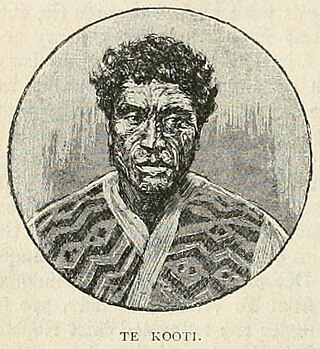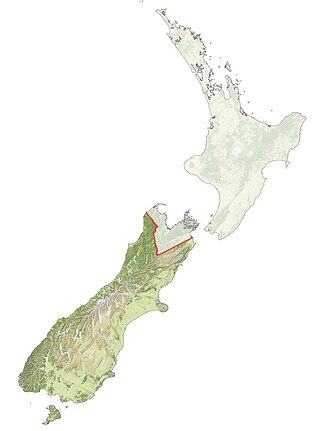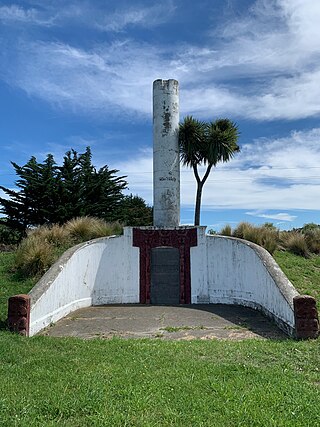Related Research Articles

Te Kooti Arikirangi Te Turuki was a Māori leader, the founder of the Ringatū religion and guerrilla fighter.

Te Rauparaha was a Māori rangatira, warlord, and chief of the Ngāti Toa iwi. One of the most powerful military leaders of the Musket Wars, Te Rauparaha fought a war of conquest that greatly expanded Ngāti Toa southwards, receiving the epithet "the Napoleon of the South". He remains one of the most prominent and celebrated New Zealand historical figures.

Ngāi Tahu, or Kāi Tahu, is the principal Māori iwi (tribe) of the South Island. Its takiwā is the largest in New Zealand, and extends from the White Bluffs / Te Parinui o Whiti, Mount Mahanga and Kahurangi Point in the north to Stewart Island / Rakiura in the south. The takiwā comprises 18 rūnanga corresponding to traditional settlements. According to the 2018 census an estimated 74,082 people affiliated with the Kāi Tahu iwi.
Tūhawaiki — often known as Hone Tūhawaiki, John Tūhawaiki or Jack Tūhawaiki, or by his nickname of "Bloody Jack" — became a paramount chief of the Ngāi Tahu Māori iwi in the southern part of the South Island of New Zealand, and was based predominantly on Ruapuke Island. He gained his nickname from early interactions with Foveaux Strait whalers on account of his red coats bought off soldiers in Australia that he and his whaling crew wore.

The Ōnawe Peninsula is a volcanic plug inside Akaroa Harbour, on Banks Peninsula in Canterbury, New Zealand. It is the site of a former pā. It is part of the Banks Peninsula Volcano.
The history of the Canterbury Region of the South Island of New Zealand dates back to settlement by Māori people in about the 14th century.
The following lists events that happened during 1831 in New Zealand.
The following lists events that happened during 1830 in New Zealand.
The following lists events that happened during 1822 in New Zealand.
The following lists events that happened during 1821 in New Zealand.
The following lists events that happened during 1820 in New Zealand.
The first Christian mission is established at Rangihoua. The Hansen family, the first non-missionary family also settles there. Samuel Marsden explores the Hauraki Gulf and travels to within sight of Tauranga Harbour. The first book in Māori is published in Sydney. The first European is born in New Zealand.

Te Pēhi Kupe was a Māori rangatira and war leader of Ngāti Toa and the uncle of Te Rauparaha. He took a leading part in what became known as the Musket Wars.
Tama-i-hara-nui , also known as Te Maiharanui and Tamaiharanui, was a New Zealand Māori chief of Ngāi Tahu. He was described as "strong and ruthless" and was a central figure in the 1820s "kai huanga" feud, meaning "eat relatives". Tama-i-hara-nui angered Ngāti Toa by letting a group of their chiefs into Kaiapoi pā and then killing them. Te Rauparaha, one of the Ngāti Toa chiefs who stayed outside of the pā, returned to Banks Peninsula in November 1830 and captured Tama-i-hara-nui. He was taken to Ōtaki, where he was tortured by the wives of the chiefs who had been killed at Kaiapoi pā, and then killed himself.
Te Mātenga Taiaroa was a leader of Ngāi Tahu, a Māori iwi (tribe) of the South Island of New Zealand. Taiaroa belonged to Ngāi Te Ruahikihiki and Ngāti Moki hapū of Ngāi Tahu, which were centred on Taumutu, at the southern end of Lake Ellesmere / Te Waihora. From the 1830s to the 1860s, he was a leader at Ōtākou on the Otago Peninsula in association with his cousin Karetai. In the 1830s, he fought against Te Rauparaha and Ngāti Toa, sometimes in conjunction with Tūhawaiki. He was later involved in peacemaking with Ngāti Toa. In 1856 he attended the meeting of Māori chiefs at Pūkawa, Lake Taupō, which elected Pōtatau Te Wherowhero as the first Māori King. In 1860 he attended the Kohimarama conference of Māori chiefs in Auckland, organised by the government. In 1859 Taiaroa was baptised by a Methodist minister and took the Christian name of Te Mātenga (Marsden). Hōri Kerei Taiaroa was one of his children.
The history of the Nelson Region of New Zealand dates back to settlement by the Māori people in about the 12th century. The Nelson and Marlborough Region were known to the Māori as Te Tau Ihu o Te Waka a Maui which means "The Prow of the Canoe of Maui".
This timeline sets out intertribal battles involving Māori people in what is now New Zealand.

Takapūneke, with the location also known as Red House Bay, is a former kāinga—an unfortified Māori village—adjacent to present-day Akaroa, New Zealand. Takapūneke was a major trading post for the local iwi (tribe), Ngāi Tahu, as there was safe anchorage for European vessels. The site is of significance to Ngāi Tahu as their tribal chief, Tama-i-hara-nui, was captured here by North Island Ngāti Toa chief Te Rauparaha, and then tortured and killed. The village itself was raided and subject of a massacre, with the events subsequently called the Elizabeth affair. There is a direct link from the massacre in 1830 to the signing of the Treaty of Waitangi in 1840, giving the site a status of national significance.
Ross Calman is a New Zealand writer, editor, historian, and translator of the Māori language.

Kaiapoi Pā is a historic pā site just north of the Waimakariri River in Canterbury, New Zealand. The pā was a major centre of trade and nobility for Ngāi Tahu in the Classical Māori period.
References
- ↑ New Zealand Encyclopaedia 1966: Busby Biography
- ↑ SuperSport: New Zealand Cricket Team
- ↑ Weller family Tree: Joseph Brooks
- ↑ "Tauranga History Timeline". Archived from the original on 14 January 2006. Retrieved 9 October 2007.
- ↑ V. A. Edgeloe (2006). "Fergusson, Sir James (1832 - 1907)". Australian Dictionary of Biography, Online Edition. Australian National University.
- 1 2 3 4 Wilson, James Oakley (1985) [First published in 1913]. New Zealand Parliamentary Record, 1840–1984 (4th ed.). Wellington: V.R. Ward, Govt. Printer. OCLC 154283103.
- ↑ Foster, B.J. (1966). "ORMOND, Hon. John Davies". An Encyclopaedia of New Zealand, edited by A. H. McLintock. Te Ara - The Encyclopedia of New Zealand.
- ↑ Simpson, Adrienne. "Elizabeth Mary Palmer". Dictionary of New Zealand Biography . Ministry for Culture and Heritage . Retrieved 23 April 2017.
- ↑ Binney, Judith - Redemption songs: a life of Te Kooti Arikirangi Te Turuki, Auckland University Press, Auckland, 1995. ISBN 1-86940-131-X, ISBN 978-1-86940-131-3. p 16
- ↑ Binney, Judith. (22 June 2007). "Kendall, Thomas 1778? - 1832". Dictionary of New Zealand Biography.